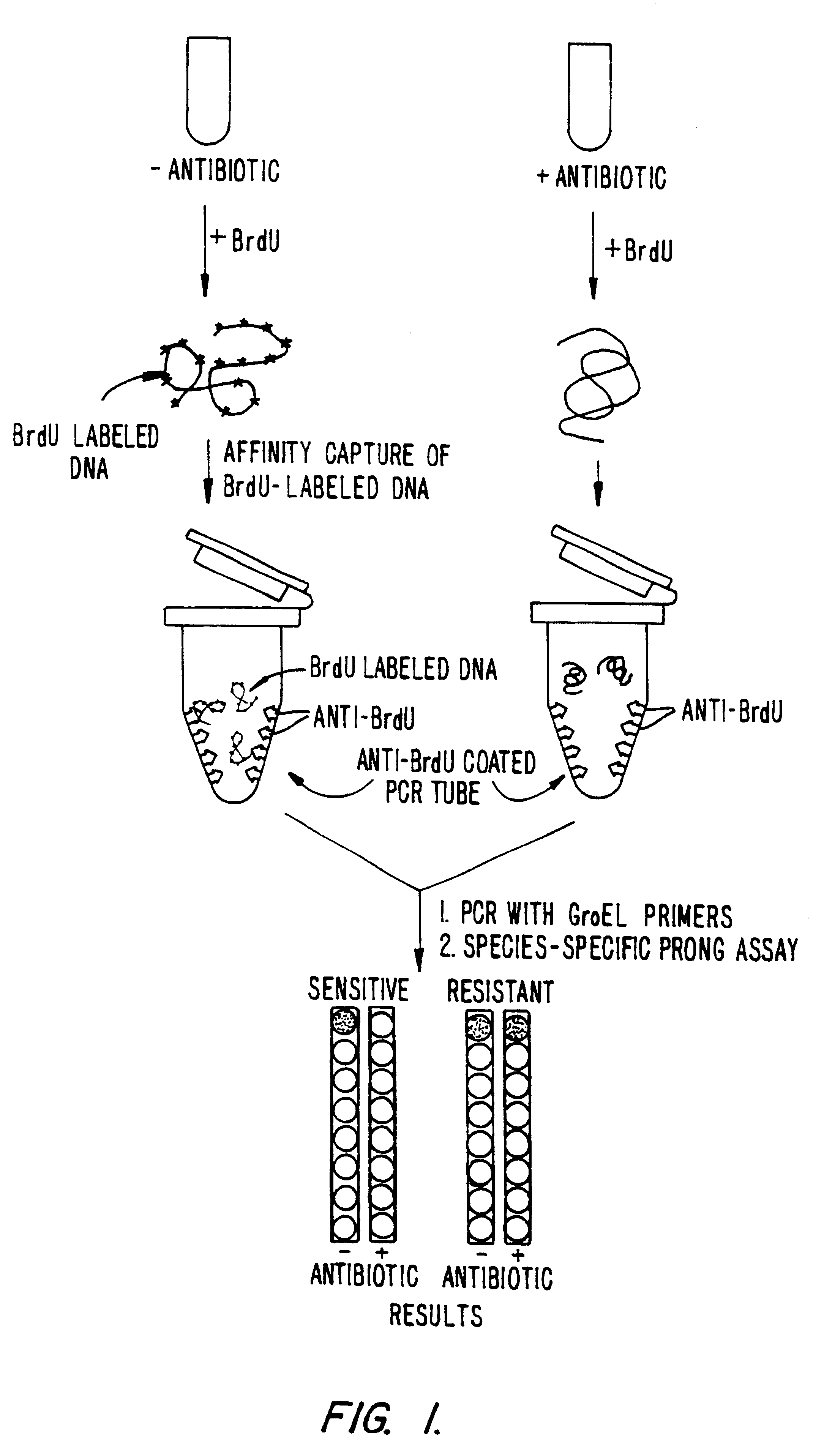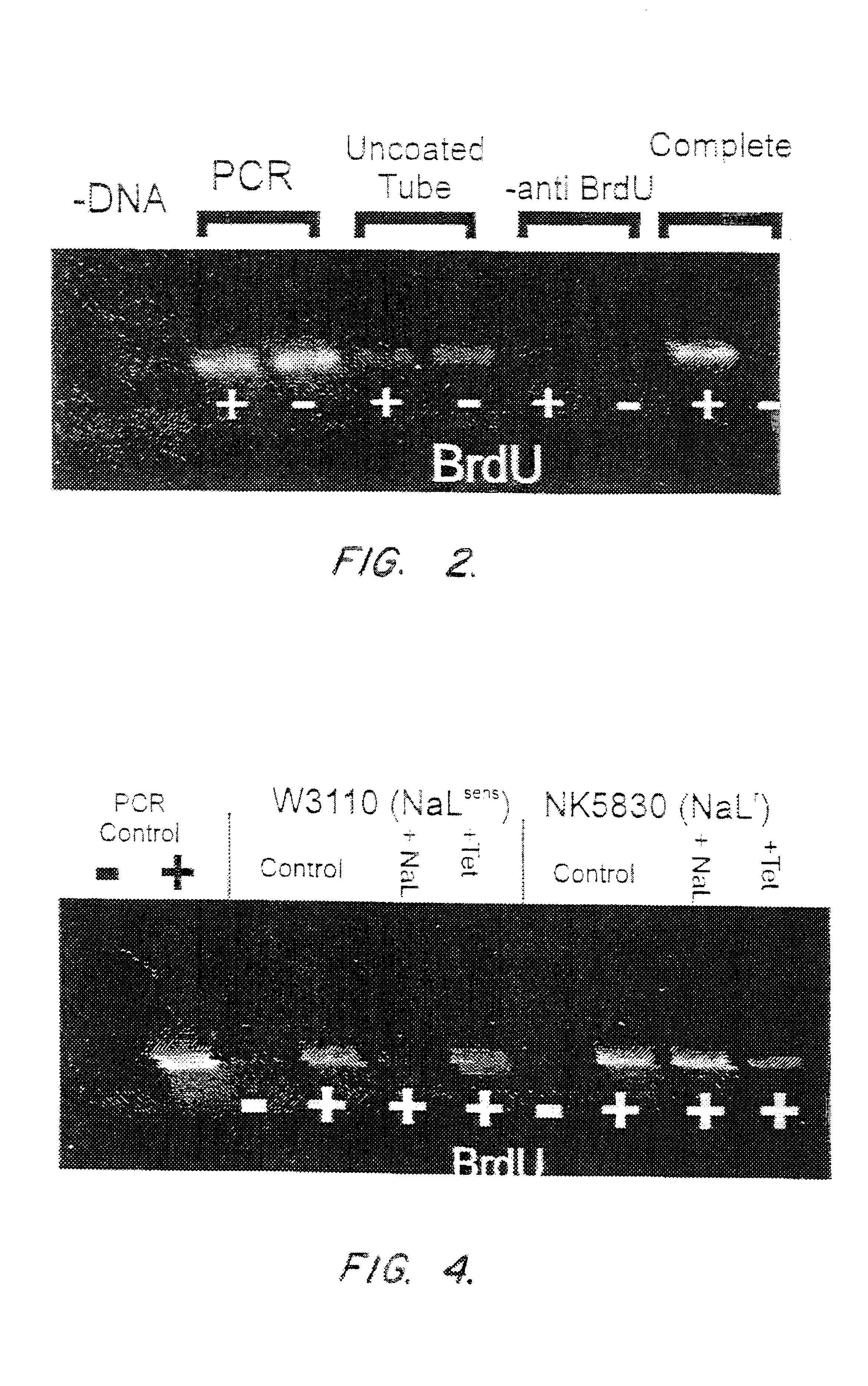Selective assay for determining the identity of live microorganisms in a mixed culture
a technology of live microorganisms and assays, applied in the field of selective assays for determining the identity of live microorganisms in mixed cultures, can solve the problems of recent precautionary recall and destruction of millions of pounds of ground b
- Summary
- Abstract
- Description
- Claims
- Application Information
AI Technical Summary
Benefits of technology
Problems solved by technology
Method used
Image
Examples
example 1
This example demonstrates incorporation of BrdU by E. coli and the ability to detect nucleic acids labeled with BrdU. For the convenience of the reader, a schematic representation of the procedure is set forth in FIG. 1.
A Procedure and Results.
E. coli cells (ATCC number 33694, more commonly referred to in the literature, and hereafter, as strain HB 101) were grown in L-Broth (Luria Broth: 10 g Bacto-Tryptone (Difco, Ann Arbor, Mich.), 5 g yeast extract, 5 g NaCl per liter). From a saturated overnight culture, 0.04 ml of cells were added to 4 ml of fresh L-Broth. Cells were shaken for about 90 minutes at 37.degree. C. until they entered early log phase (this is usually 1 to 1.5 hours for E. coli). Then, 0.04 ml of 100 mM BrdU was added and the cells were grown until the culture reached saturation, as determined by turbidity.
DNA purification was carried out as follows (this protocol is referred to in the examples following as the chemical disruption method). Cells were spun in a micro...
example 2
These studies show the ability of the invention to determine differences in sensitivity to antibiotics between different strains of the same microorganism.
A nalidixic acid resistant strain of E. coli (ATCC number 27325, commonly referred to in the literature as strain W3110) and a nalidixic acid resistant strain (ATCC number 47056, commonly referred to as strain NK5830) were inoculated into L-broth in separate containers and cultured until early log phase (usually reached in E. coli in 1 to 1.5 hours). At 1.5 hours, the two cultures were inoculated into separate series of containers. Each series of containers was then divided into groups. Nalidixic acid was added to the first group of each series, to a final concentration of 100 .mu.g / ml. Tetracycline was added to the second group of each series, to a final concentration of 100 .mu.g / ml. No antibiotic was added to the third group of each series, which served as a control. All the cultures in each series were then incubated for a fur...
example 3
This example shows that the invention can be used to detect antibiotic-resistant microorganisms in a mix with antibiotic-susceptible organisms of the same species.
In these studies, the nalidixic acid-resistant E. coli strain NK5830 was mixed with the nalidixic acid-sensitive strain W3110 in various proportions. Saturated overnight mixed cultures were diluted in fresh L-broth at 1:100, to a total inoculum volume of 401 .mu.l. Cells were then grown for 1.5 hours, and nalidixic acid was added. After incubation for 1 more hour, BrdU was added and growth continued for 30 minutes. The immunocapture experiment was then performed on either purified DNA or on crude sodium hydroxide lysates.
The results are presented in FIG. 6. The first two lanes are again the PCR controls, either without (-) or with (+) the addition of DNA. The next two lanes designated "control," were immunocapture assay controls to which no was added. The samples in the first control lane, labeled "-", had no BrdU added du...
PUM
| Property | Measurement | Unit |
|---|---|---|
| volume | aaaaa | aaaaa |
| pH | aaaaa | aaaaa |
| pH | aaaaa | aaaaa |
Abstract
Description
Claims
Application Information
 Login to View More
Login to View More - R&D
- Intellectual Property
- Life Sciences
- Materials
- Tech Scout
- Unparalleled Data Quality
- Higher Quality Content
- 60% Fewer Hallucinations
Browse by: Latest US Patents, China's latest patents, Technical Efficacy Thesaurus, Application Domain, Technology Topic, Popular Technical Reports.
© 2025 PatSnap. All rights reserved.Legal|Privacy policy|Modern Slavery Act Transparency Statement|Sitemap|About US| Contact US: help@patsnap.com



